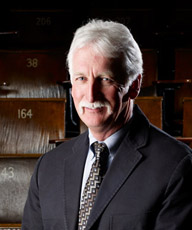William L. Jorgensen
William L. Jorgensen | |
|---|---|
 | |
| Born | October 5, 1949 |
| Alma mater | Princeton University, Harvard University |
| Known for | OPLS force field, TIPnP, FEP |
| Scientific career | |
| Fields | Computational Chemistry |
| Institutions | Yale University |
| Doctoral advisor | Elias J. Corey |
William L. Jorgensen (born October 5, 1949, New York) is a Sterling Professor of Chemistry at Yale University.[1] He is considered a pioneer in the field of computational chemistry. Some of his contributions include the TIP3P, TIP4P, and TIP5P water models, the OPLS force field, and his work on free-energy perturbation theory for modeling reactions in solution, protein-ligand binding, and drug design; he has over 450 publications in the field. Jorgensen was the Editor of the ACS Journal of Chemical Theory and Computation from its founding in 2005 until 2022.
Background and achievements
[edit]Jorgensen earned a bachelor's degree from Princeton University in 1970 and a Ph.D. from Harvard University in 1975 in Chemical Physics while studying under Elias J. Corey. Jorgensen then worked at Purdue University from 1975 to 1990 first as an assistant professor and then later as a Professor. He joined the Yale faculty in 1990 and has remained there since. Jorgensen's work has been recognized by many awards including election to the American Academy of Arts and Sciences, the National Academy of Sciences, and the International Academy of Quantum and Molecular Sciences. He has also received the ACS Award for Computers in Chemical and Pharmaceutical Research, the ACS Hildebrand Award, the Tetrahedron Prize, and Arthur C. Cope Award.
Research interests
[edit]Jorgensen's research interests are broad and include the calculation of free energy of reactions using quantum mechanics, molecular mechanics, and Metropolis Monte Carlo methods, with application to the calculation of protein-ligand binding affinities, which have pharmaceutical applications. Most generally, the research goals include the development of theoretical and computational methods in order to gain a deeper understanding of structure and reactivity for organic and biomolecular systems. His research group has also pursued de novo drug design, synthesis, and protein crystallography, particularly for anti-infective, anti-proliferative, and anti-inflammatory agents. He pioneered the use of free-energy perturbation calculations for widespread applications including efficient drug lead optimization. With these methods, he developed improved NNRTI's, which are used for the treatment of HIV. In addition, his group in 2020 rapidly discovered inhibitors of the main protease of the SARS-CoV-2 virus.
See also
[edit]Sources
[edit]- ^ "William L. Jorgensen Has Been Appointed as Sterling Professor of Chemistry". Yale University Office of Public Affairs. 2009-05-15. Archived from the original on 2012-07-30. Retrieved 2009-06-14.
2. Jorgensen, W.L. Computer-Aided Discovery of Anti-HIV Agents. Bioorg. Med. Chem. 2016, 24, 4768-4788.
3.- Cabeza de Vaca, I.; Zarzuela, R.; Tirado-Rives, J.; Jorgensen, W. L. Robust FEP Protocols for Creating Molecules in Solution. J. Chem. Theory Comput. 2019, 15, 2734-2742.
4.- Qian, Y.; Cabeza de Vaca, I.; Vilseck, J. Z.; Cole, D. J.; Tirado-Rives, J.; Jorgensen, W. L. Absolute Free Energy of Binding Calculations for Macrophage Migration Inhibitory Factor in Complex with a Drug-like Inhibitor. J. Phys. Chem. B 2019, 123, 8675-8685.
5.- Ghahremanpour, M.; Tirado-Rives, J.; Deshmukh, M.; Ippolito, J. A.; Zhang, C.-H.;Cabeza de Vaca, I.; Liosi, M.-E.; Anderson, K. S.; Jorgensen, W. L.Identification of 14 Known Drugs as Inhibitors of the Main Protease of SARS-CoV-2. ACS Med. Chem. Lett. 2020, 11, 2626-2533.>
6.- Zhang, C.-H.; Stone, E. A.; Deshmukh, M.; Ippolito, J. A.; Ghahremanpour, M.M.; Tirado-Rives, J.; Spasov, K.A.; Zhang, S.; Takeo, Y.; Kudalkar, S.N.; Liang, Z.; Isaacs, F.; Lindenbach, B.; Miller, S.J.; Anderson, K. S.; Jorgensen, W. L Potent non-covalent inhibitors of the main protease of SARS-CoV-2 from molecular sculpting of the drug parampanel guided by free-energy perturbation calculations. .ACS Central Sci. 2021, 7, 467-475.
